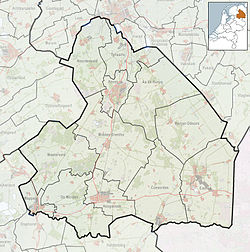History
Westervelde is an esdorp which developed in the Middle Ages on higher grounds. The communal pasture of the village is triangular. [3] It was first mentioned in 1484 as Westeruelde. The name means western field. [4] It was established as a daughter settlement of Norg. [3]
Huis te Westervelde or Tonckensborg dates from the 17th century, but has been extensively rebuilt in the late 18th century. Since 1709, it was home to the Tonckens family. [3] It is currently in use as an hotel. [5] Other nobility also built estates in Westervelde. [5] The whole village has been designated a protected area. [3]
Westervelde is the site of a Neolithic burial site called hunebed (Dolmen) D2 [ nl ] which is located near the Norgerholt forest. Originally, it had four covering stones, but only two remain. [6] The area around Westervelde is characterised by large forests and agricultural fields, and mainly has a recreational use. [5]
This page is based on this
Wikipedia article Text is available under the
CC BY-SA 4.0 license; additional terms may apply.
Images, videos and audio are available under their respective licenses.






